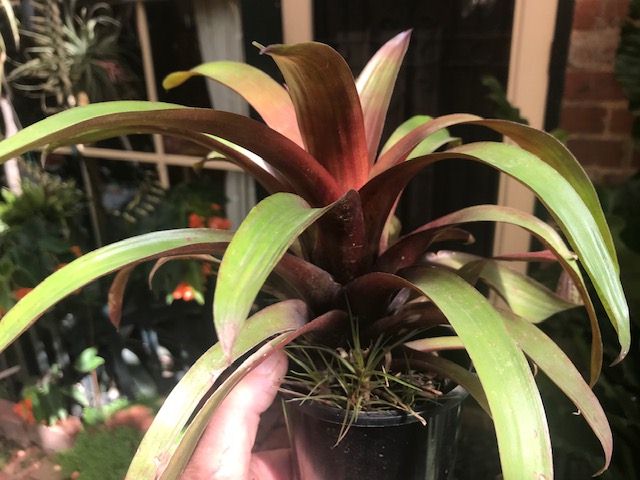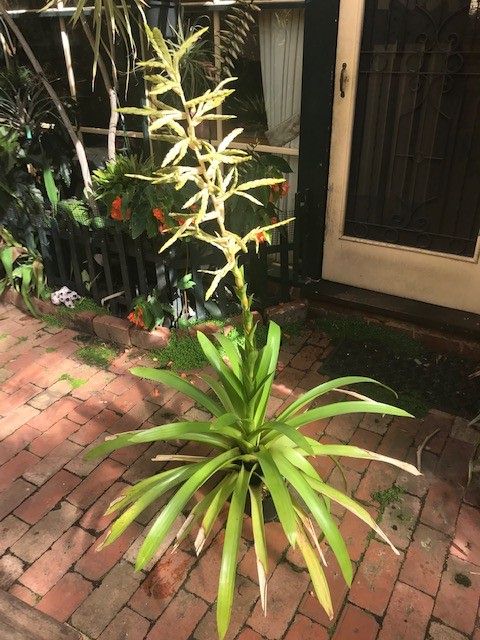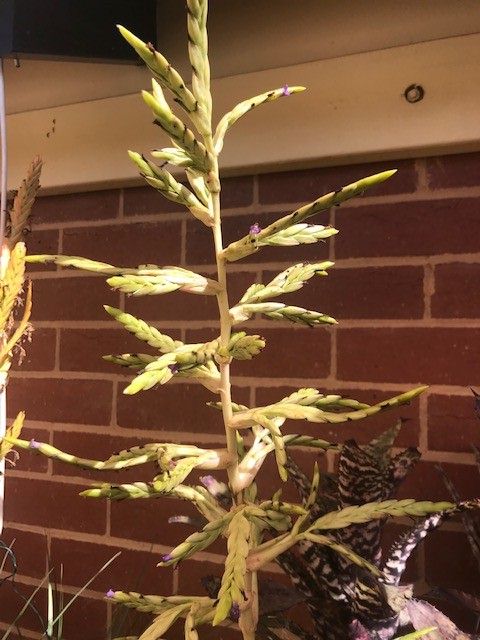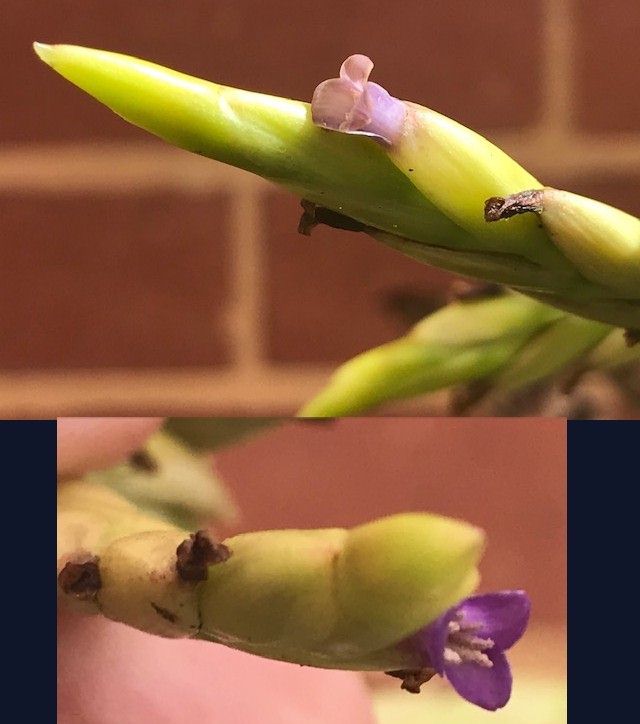



pyramidata aff. Young plant with grass pups on left. See notes. |
Tillandsia pyramidata var pyramidata
Flowers all normal.
Type Andre 1522 (holotype K, US photo), Barroblanco, western slopes of Cordillera
Oriental, Cundinamarca, Colombia, Feb 1876.
DISTRIBUTION. On open rocky slopes and epiphytic in forest, 2000-2600 m alt, Colombia, Ecuador, Peru.
COLOMBIA. NARINO: Sibundoy lowland, 28 Oct 1946, Foster 1964 (COL, GH). ECUADOR. LOLA: Rio Tanta, km 71 Loja to Cuenca, 12 Aug 1966, Gilmartin 1151 (US). PERU. HUANUCO: Yanano, May 1923, Macbride 3852 (F); Valley of Huanuco, 1967, Rauh 21191 (HEID, US). JUNIN: Carpapata, above Huacapistana, 7
un 1929, Killip & Smith 24357 (GH, US); Tarma to Huacapistana, 28 Jun 1948, Ferreyra 3721 (US, USM); Palca, 30 Jul 1966, La Rosa & Riccio 1480 (US, USM); Tarma, Sep 1967 ,Rauh 21146 (HEID, US). APURIMAC: Andahuaitas: Quebrada de Pisocoi, 6 Jan 1950, Vargas 8808 (US). Cuzco: Valley of Paucartambo, Rauh P-61 (US); Pillahuata, Yanamayo to Tambomayo, 3 Nov 1965, Vargas 16717 (US).
Tillandsia pyramidata var vivipara Rauh, Akad. Wiss. & Lit. Mainz 1973(3): 17, fig. 7. 1973.
Flowers largely viviparous.
Type. Rauh 23686a (holotype HEID, isotype US), terrestrial, near Tarma, 2600 m alt, Junin, Peru, Jul 1970.
DISTRIBUTION. Known from the type collection only.
14. Tillandsia pyramidata Andre, 1889, Bromel. Andreanae, p. 86. Fig. 20
Desc in Gilmartin 1972
PLANT to 150 cm tall;
LEAVES 35-40 cm long, blades 4.5-5.0 cm wide, pale green, red toward apex, lingulate, very minutely punctulate below, subglabrous above, sheath ca. 15 cm long by 7.5 cm wide, slightly purple, elliptic, conspicuous;
INFLORESCENCE ca. 33 cm long by 20 cm in diam., bipinnate, with ca. 8 branches, ellipsoid, glabrous;
SCAPE ca. 145 cm long with inflorescence by 8-9 mm in diameter, erect;
SCAPE-BRACTS 8.0-10.0 cm long by 3.5 cm wide, imbricate, green to purple, erect;
PRIMARY BRACTS 4.0-6.0 cm long by 2.5-3.0 cm wide, erect, ovate, glabrous, apex acute to attenuate;
BRANCHES 8.0-11.0 cm long by 2.5-3.0 cm wide, erect at branch base then decurving, elliptic, stipe 1.4-4.0 cm long;
FLORAL BRACTS 2.0-2.1 cm long by 1.9-2.0 crn wide, erect, imbricate, ovate, glabrous without, lepidote within, apex broadly acute, bicarinate with rounded backs, coriaceous, not nerved;
SEPALS 1.8-1.9 cm long by 1.0 cm wide, erect, posteriorly connate for 5-6 mm, elliptic, not nerved, glabrous without, lepidote within, carinate posteriorly, broadly acute,
OVARY ca. 6 mm long, distance between flowers 5 mm.
MATERIAL EXAMINED: Gilmartin 1151 (US) km 71 Loja-Cuenca, slopes above Rio Tanta, Prov. Loja, ca. 2300 m, 12 August 1966.
COLOMBIA, PERU.
NOTES: The great elongation of the scape may not be typical, as Gilmartin 1151 has several vegetatively produced plantlets growing from the axils of some floral bracts. Frequently when a bromeliad plant has these vegetatively produced plantlets there is a concomittant greater than normal elongation of the scape. Very common locally at km 71 Loja-Cuenca, growing on steep rocky hillsides.
Tillandsia pyramidata Andre (1889). emend by Rauh, Trop Subtrop Pflanz 3: 15-9. 1973
T. pyramidata has already been described by Andre in 1889 and the Type is reported only for Colombia (Eastern slopes of the Andes near Barro blanco). Also in “Flora von Peru”,(volume XIII, Nr. 3, 1936), T. pyramidata is not mentioned.
On my last trip to Peru, I collected a Tillandsia below the city of Tarma (central-Peru) on rock faces at 1600-2000 m high, that I thought was T. denudata. Investigation of the material by L. B. SMITH yielded however, that its nearest relative was T. pyramidata, which is therefore new for Peru. The differences between both species following L. B. SMITH is as follows.
T. pyramidata: all spikes not branched, the basal ones postfloral bent clearly downwards; its sterile sections always shorter than the primary bracts (fig. 8).
T. denudata: basal spike usually branched, always erect and not hanging; its sterile sections longer than the primary bracts.
Subsequently the diagnosis of the plant collected by me near Tarma by L. B. Smith revealed it as T. pyramidata:
Plant stemless, flowering to 2 m high.
Leaves in dense, spreading, to 80 cm in diameter and to 60 cm high rosette (fig. 7, left).
Sheaths wide-oval, gradually merging into the blade, to 10 cm long and to 9 cm wide, upperside light-leather-brown, dense and small appressed light brown lepidote, underneath dark brown lepidote.
Blade ligulate, its edges at the base bent inwards, to 6 cm wide, in the upper third tapering to a sharp, bent back tip, both sides lively green, scattered and small white lepidote or yellow-green, membranous with a red tip.
Scape erect, 1-1,5 m long, at the base to 3 cm thick, green or red.
Scape bracts lax, the basal ones subfoliate, the middle ones longer than the internodes, with ligulate, rolled back, green blade, the upper ones crimson with short blade.
Inflorescence very lax, 50-100 cm long, with thin, dark carmine red axis and ± 13, spreading, simple, horizontally spreading to bent over spike (fig. 8).
Primary bracts shorter than the spike, but as long as the 1-3 cm long, sterile section, shiny dark-crimson, glabrous, towards the top on both sides scattered and small lepidote, the middle ones long-triangular, sharply acuminate, to 7 cm long and 3 cm wide.
Spike sword shaped, both sides somewhat convex, with a sterile section, to 10 cm long and 2 cm wide (fig. 8).
Floral bracts densely imbricate, up to the middle sharply keeled, sharply tipped, excavated at the base, to 22 mm long, spreading to 17 mm wide, strong, smooth, when dried not nerved, glabrous, on the inside small brown lepidote, at the base yellow green, membranous somewhat frosty waxy, at the edge and in the upper third shiny crimson; the basal, sterile bracts uniformly crimson.
Sepals 15-22 mm long, acuminate, the posterior pair carinate, the anterior ecarinate, unequally high connate, the rear 5 mm, the fore 3 mm high.
Petals exceeding the sepals by about 5 mm, tongue-shaped, acuminate, with rolled back tips, violet-blue.
Stamens and Style enclosed.
Collection No. Rauh 23886 (July 1970).
Together with the type, there is a variety found at the same location, that differ by having extensive vegetative increase in the area of the Inflorescence and is therefore treated as:
var. vivipara Rauh, var. nov as follows.
A typo differt surculis adventitis ex axillis bractearum scapi, bractearum primarium et bractearum floralium orientibis.
Habitat: in terra et rupibus prope Tarman, apud 1600 m.s.m.
Holotypus: Rauh 23686a (July 1970).
With the var. vivipara the offsets appear in such large numbers, that the inflorescence is fully covered, and you see hardly anything of the spikes,( fig. 7). They originate as well as in the axils of the scape bracts of the scape (fig. 7, left, fig. 8 I) and also in the axils of the primary bracts as well as the spikes (fig. 8 III). They come also in the axils of the peduncle bracts (fig. 8, IIb, x,) the bracts in the sterile basal section of the spike as well as in the axils of the actual floral bracts. In a more final case, the offsets occupy the position of the flowers. They usually emerge before anthesis, more rarely first postfloral.
The offsets break off very easily, fall to ground and take root. As with T. propagulifera the extensive vegetative increase causes the formation of large stands growing on steep rock faces and also on the ground.
Near Tarma T. pyramidata var. vivipara grows abundantly with the magnificent flowering, large T. macrodactylon Mez.